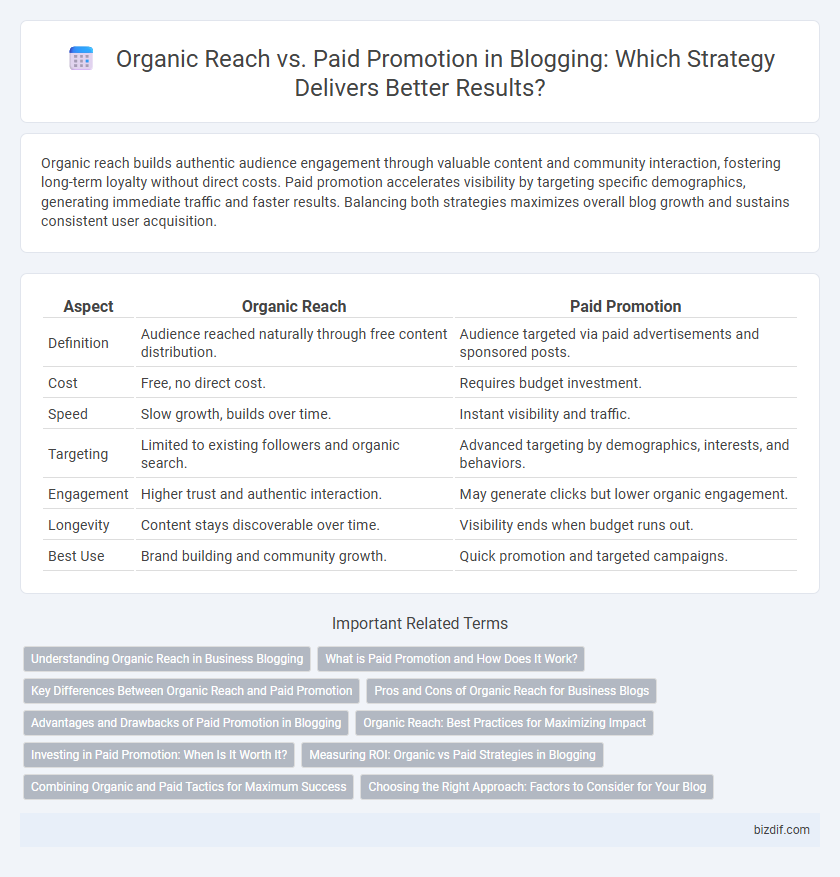Organic reach builds authentic audience engagement through valuable content and community interaction, fostering long-term loyalty without direct costs. Paid promotion accelerates visibility by targeting specific demographics, generating immediate traffic and faster results. Balancing both strategies maximizes overall blog growth and sustains consistent user acquisition.
Table of Comparison
| Aspect | Organic Reach | Paid Promotion |
|---|---|---|
| Definition | Audience reached naturally through free content distribution. | Audience targeted via paid advertisements and sponsored posts. |
| Cost | Free, no direct cost. | Requires budget investment. |
| Speed | Slow growth, builds over time. | Instant visibility and traffic. |
| Targeting | Limited to existing followers and organic search. | Advanced targeting by demographics, interests, and behaviors. |
| Engagement | Higher trust and authentic interaction. | May generate clicks but lower organic engagement. |
| Longevity | Content stays discoverable over time. | Visibility ends when budget runs out. |
| Best Use | Brand building and community growth. | Quick promotion and targeted campaigns. |
Understanding Organic Reach in Business Blogging
Organic reach in business blogging refers to the number of people who discover content naturally through search engines, social media shares, or direct visits without paid advertising. Prioritizing high-quality, relevant blog posts optimized for SEO keywords enhances visibility and drives sustainable traffic over time. Consistent engagement through authentic content builds trust and brand authority, crucial for long-term organic growth compared to short-term gains from paid promotion.
What is Paid Promotion and How Does It Work?
Paid promotion in blogging involves using advertising platforms like Google Ads or social media ads to amplify content visibility beyond organic reach. Advertisers bid on keywords or target specific demographics, allowing content to appear in designated user feeds or search results based on relevance and budget. This method provides immediate traffic boosts and precise audience targeting, contrasting organic strategies that rely on SEO and natural user engagement.
Key Differences Between Organic Reach and Paid Promotion
Organic reach on blogs depends on SEO techniques, quality content, and user engagement, attracting visitors without direct advertising costs. Paid promotion leverages targeted ads, boosting visibility through budget allocation on platforms like Google Ads or social media channels. Key differences include cost structure, control over audience targeting, and speed of traffic generation, with organic reach growing gradually and paid promotion delivering immediate, scalable results.
Pros and Cons of Organic Reach for Business Blogs
Organic reach for business blogs drives authentic audience engagement by leveraging SEO strategies and quality content, resulting in higher trust and long-term brand loyalty. However, its limitations include slower growth compared to paid promotion and dependency on algorithms that can reduce visibility. Despite these challenges, organic reach offers cost-effective traffic acquisition with potential for sustainable audience building.
Advantages and Drawbacks of Paid Promotion in Blogging
Paid promotion in blogging offers immediate visibility and targeted audience reach through platforms like Google Ads and social media campaigns, accelerating traffic growth and brand awareness. However, costs can escalate quickly without guaranteed long-term engagement, and ads may face ad fatigue or blockades from ad blockers reducing effectiveness. Unlike organic reach, which builds sustainable credibility and loyal readership over time, paid promotion requires ongoing investment and strategic budget management to maintain results.
Organic Reach: Best Practices for Maximizing Impact
Maximizing organic reach in blogging involves creating high-quality, relevant content that resonates with the target audience and encourages engagement through comments, shares, and likes. Utilizing SEO strategies such as keyword optimization, meta descriptions, and internal linking enhances visibility on search engines, driving sustainable traffic without additional costs. Consistently publishing valuable posts and actively engaging with readers on social media networks builds trust and amplifies organic discovery over time.
Investing in Paid Promotion: When Is It Worth It?
Investing in paid promotion is worth it when organic reach plateaus or fails to target demographically specific audiences effectively, enabling precise audience segmentation and faster visibility growth. Paid promotion offers measurable ROI through analytics tools, allowing bloggers to optimize campaigns in real time, maximizing engagement and conversion rates. This strategic investment supports brand awareness and traffic generation, especially during product launches, events, or competitive niches where organic algorithms limit exposure.
Measuring ROI: Organic vs Paid Strategies in Blogging
Measuring ROI in blogging requires analyzing both organic reach and paid promotion metrics such as traffic sources, conversion rates, and engagement levels. Organic reach leverages SEO and content quality to generate sustainable, long-term results with lower direct costs, while paid promotion delivers faster visibility and targeted audience reach but requires ongoing investment. Evaluating key performance indicators (KPIs) like cost per acquisition (CPA) and return on ad spend (ROAS) helps bloggers optimize budget allocation between organic efforts and paid campaigns.
Combining Organic and Paid Tactics for Maximum Success
Combining organic reach with paid promotion leverages the strengths of both strategies to maximize blog visibility and engagement. Organic tactics build long-term audience trust and sustainability through authentic content, while paid campaigns provide targeted, immediate traffic boosts and scalable results. Integrating SEO, quality content, and data-driven ads ensures a balanced approach that drives consistent growth and higher conversion rates.
Choosing the Right Approach: Factors to Consider for Your Blog
Evaluating organic reach versus paid promotion for your blog depends on factors like target audience, budget, and content goals. Organic reach builds long-term engagement through quality SEO, social sharing, and keyword optimization, while paid promotion delivers immediate traffic via targeted ads on platforms like Google Ads or Facebook Ads. Assessing metrics such as cost per click (CPC), conversion rate, and audience demographics enables bloggers to choose a balanced strategy that maximizes visibility and ROI.
Organic reach vs paid promotion Infographic

 bizdif.com
bizdif.com